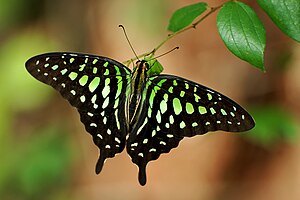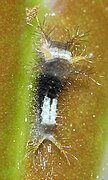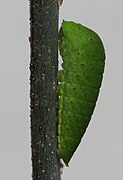Graphium agamemnon
| Graphium agamemnon | ||||||||||||
|---|---|---|---|---|---|---|---|---|---|---|---|---|

Graphium agamemnon |
||||||||||||
| Systematics | ||||||||||||
|
||||||||||||
| Scientific name | ||||||||||||
| Graphium agamemnon | ||||||||||||
| ( Linnaeus , 1758) |
Graphium agamemnon ( synonym : Papilio agamemnon ) is a occurring in Asia and Australia butterfly from the family of the swallowtail butterfly (Papilionidae), and the subfamily swallowtails (Papilioninae). The specific epithet goes back to Agamemnon , a military leader from Greek mythology .
features
butterfly
The wingspan of the moth is 70 to 100 millimeters. There is no sexual dimorphism between the sexes , as males and females have the same drawing elements. The forewings are slightly curved and form a strong point at the apex . There is a short tail process near the anal angle of the hind wings. All wing tops have a black basic color, which is covered by a clear green pattern of spots. The drawing on the bottom is similar to the top, but shows a brown base color. In the basal region , a red-brown, black spot stands out.
Pre-imaginal stages
The egg is round, smooth and creamy white to light yellow in color.
The bead is predominantly black in its first stage in the front region and whitish at the end, characterized resemble bird droppings. This bird droppings mimicry is a very effective protection against predators. In the second stage, the area behind the head swells like a balloon. Then it changes color to a light green with dark green spots. In the third and fourth stages, it also shows short, lateral spines on the anterior three thoracic segments and on the anal segment. The adult caterpillar has a smooth body surface, is almost a solid green and tapers towards the end of the body. To deter predators, the caterpillars are able to turn out an osmaterium .
The doll has an elongated shape, is predominantly green in color and has a horn-like rust-brown thickening on the back of the head. It is attached to branches as a belt doll .
Distribution, subspecies and habitat
The species occurs from India , Sri Lanka , Nepal and southern China eastwards through Southeast Asia to Australia . Twenty subspecies are currently classified in the various occurrence areas . Graphium agamemnon inhabits moist deciduous forests and river banks as well as rural areas. Through the cultivation of Polyalthia longifolia (the main food plant of the caterpillars) in gardens, the species is increasingly found in cities.
Way of life
The moths fly in successive generations. The eggs are laid individually on young leaves of the food plant. They need three to four days for the caterpillars to hatch, which then go through five stages over a period of 15 to 16 days to pupate. The puppet time is 13-14 days. On average, seven to eight generations are formed each year. The moths like to stay in higher tree regions. While the females occasionally visit flowers, the males suckle on excrement or damp places on the ground in order to absorb fluids and minerals. The caterpillars prefer to feed on the leaves of Polyalthia longifolia as well as magnolias ( Magnolia ) or Annona species.
Trivia
In 1758, Carl von Linné named the epithet of many butterfly species in his Systema naturae (10th edition) after people from Greek mythology, including Papilio agamemnon , whose name can be traced back to Agamemnon , a ruler of Mycenae and military leader in the Trojan War . Other species that were referred to as “ Trojan Knights” ( Equites Trojani ) or “ Achaic Knights” ( Equites Achivi ) include the following (with their namesake): Papilio priamus ( Priamos ), Papilio hector ( Hector ), Papilio paris ( Paris ), Papilio ulysses ( Odysseus ), Papilio helena ( Helena ), Papilio menelaus ( Menelaos ) and Papilio achilles ( Achilles ). Linnaeus used the generic name Papilio for all of these species , but this has partly changed according to the latest taxonomic findings. The species discussed here is now called Graphium agamemnon .
Individual evidence
- ↑ John L. Heller: Classical mythology in the Systema Naturae of Linnaeus , The Johns Hopkins University Press, Vol. 76, 1945
- ↑ caterpillars
- ^ Charles Thomas Bingham: The Fauna of British India, including Ceylon and Burma. Butterflies. Vol. II, Taylor & Francis, London, 1907
- ↑ Distribution and subspecies
- ↑ a b S. B. Ramana, JB Aturi & S. Reddi: Autecology of the tailed jay butterfly Graphium agamemnon (Lepidoptera: Rhopalocera: Papilionidae). , J Environ Biol. No. 24 (3), 2003
- ↑ Food plants
- ^ Carl von Linné: Systema naturæ per regna tria naturæ, secundum classes, ordines, genera, species, cum characteribus, differentiis, synonymis, locis. Tomus II. Editio decima, reformata. , Holmiae. (Salvius), 1758
Web links
- ifoundbutterflies - Butterflies of India






